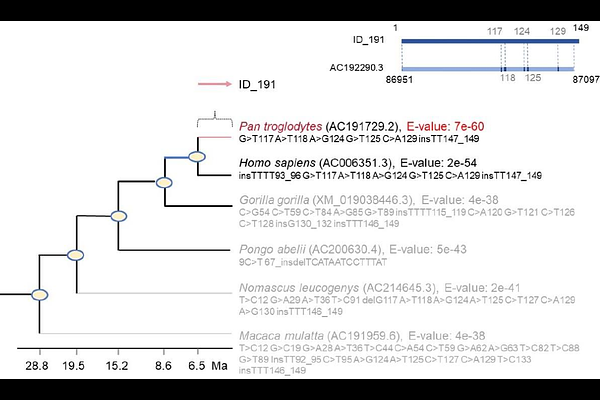Ancient DNA Reveals Hominoid Evolution: Intermediate DNA Sequences and Advances in Molecular Paleontology

Ancient DNA Reveals Hominoid Evolution: Intermediate DNA Sequences and Advances in Molecular Paleontology
Zhao, L.; Zhang, S.; Guo, Z.; Zhong, Q.; Zheng, Y.; Cai, Y.; Jia, C.; Zhang, S.; Mao, R.; Hong, C.; Wu, M.; Wang, Y.; Zheng, Z.; Zhang, Y.; Jin, Y.; Zhao, W.
AbstractFossils and ancient crude pottery vessels function as physical DNA containers, preserving oriDNA (original, in situ DNA) and accumulating eDNA (environmental DNA) over time. Ancient DNA (aDNA) serves as molecular fossils, chronicling evolutionary history. Using nano-affinity bead technology, we extracted and sequenced DNA from Lycoptera fossils in the Jehol region and a round-bellied jar (Jar) from the Erlitou period in Guangwu Town, yielding 236,545 primate sequences from the fossils and 86,908 from the pottery. We observed that the AFF value of DNA sequences negatively correlates with species divergence time1, offering a quantitative measure of DNA preservation and host divergence. Some fragments distinct from modern genomic sequences, termed intermediate DNA sequences (IDS), have been identified. Many IDS exhibit an upper age limit, preserving characteristics of the last common ancestor (LCA) of the Hominidae and offering molecular insights into Darwin\'s puzzle. Among IDS, the SRRA subtype (Sequence Reversal and Rearrangement), identified in mRNA-coding exonic sequences, arises from the incorporation of a complementary antisense strand upstream of the sense strand, either adjacent to it or separated by a sequence interval. This introduces a novel post-transcriptional regulatory mechanism at the mRNA level, driven by SRRA, which presets hairpin structures and Indels in the UTR or CDS of exonic sequences, modulating gene variation. We propose: SRRAs played a critical trial-and-error role in early Hominidae evolution, facilitating adaptive genomic changes, with some SRRA sequences later excised from exons, positioning SRRA as an evolutionary genetic switch. Additionally, seven species-specific fragments (SSFs) of non-human primates (NHPs) linked to Asian Homo erectus were identified in the fossils, and pottery DNA revealed sequences from tropical species (e.g., zebrass, oil palms), providing evidence of climate-driven local extinction and supporting paleo-ecological and paleo-environmental reconstruction. This method of analyzing aDNA from non-skeletal materials opens new avenues in paleontology, archaeology, and geology, guiding the tracing of ancient migration patterns and fossil searches. DNA fragments preserved within DNA container exhibit an old-few, new-many turnover pattern, with many aDNA fragments displaying non-deamination. This evidence challenges prevailing perspectives, the authenticity criteria for aDNA, and the capabilities and scope of the traditional research method, necessitating a thorough reevaluation of the relevant knowledge framework. Furthermore, this study opens new opportunities for frontier research.